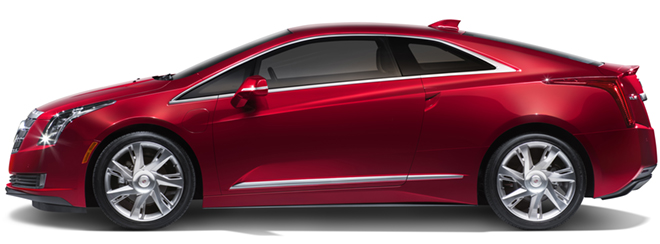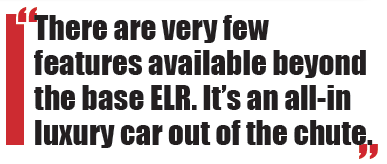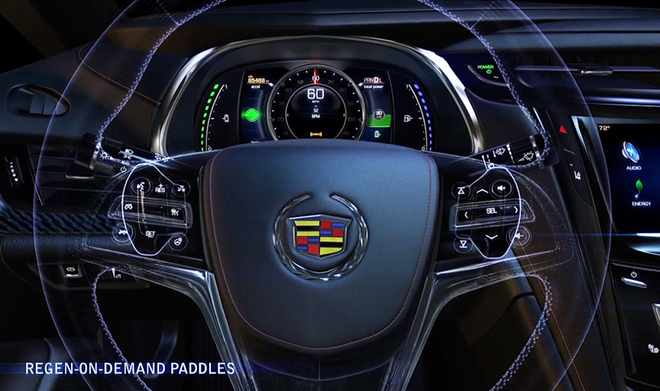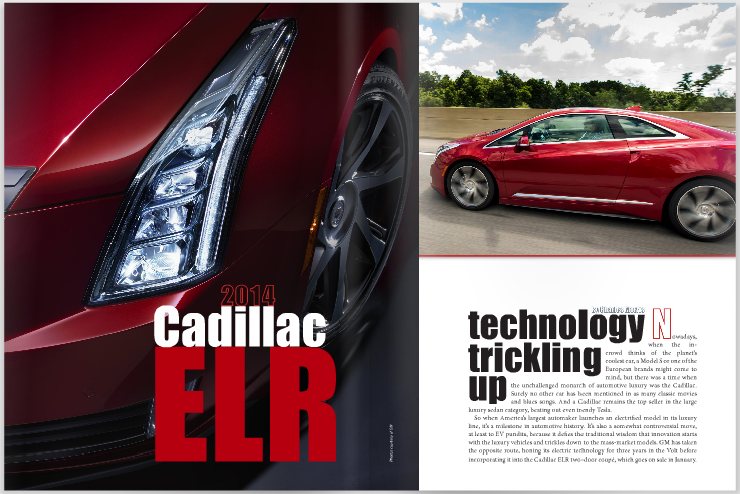Nowadays, when the in-crowd thinks of the planet’s coolest car, a Model S or one of the European brands might come to mind, but there was a time when the unchallenged monarch of automotive luxury was the Cadillac. Surely no other car has been mentioned in as many classic movies and blues songs. And a Cadillac remains the top seller in the large luxury sedan category, beating out even trendy Tesla.
So when America’s largest automaker launches an electrified model in its luxury line, it’s a milestone in automotive history. It’s also a somewhat controversial move, at least to EV pundits, because it defies the traditional wisdom that innovation starts with the luxury vehicles and trickles down to the mass-market models. GM has taken the opposite route, honing its electric technology for three years in the Volt before incorporating it into the Cadillac ELR two-door coupé, which goes on sale in January.


Charged spoke with Kevin Kelly, GM’s Manager of Electrification Technology Communications, as well as ELR Chief Engineer Chris Thomason and Product Manager Darin Gesse. They told us that the rationale behind GM’s strategy had to do with the newness of the technology. The combination of an electric powertrain with a gasoline range extender was something that had never been available before, and early Volt customers knew that they were taking a risk by buying the vehicles.
As Gesse told us, many Volt buyers are the type of customers who could afford a luxury car, but want to be on the cutting edge. That customer base has been a huge asset for GM, offering invaluable feedback on their real-world experience with the car. However, the luxury car buyers who will be interested in the ELR are not the beta-testing type. “They are our fast followers, who want to be part of the change, but they want to make sure the tech has been proven – they wait for the first review, see that it works and has been refined, then they jump on board.” The Volt now has over 500 million miles under its fan belt – the beta test is over, and it’s time for the luxury buyer to experience what the technology can do.
Several reviewers have expressed a bit of sticker shock at the lofty price of the ELR – Consumer Reports said the car is “priced out of its league,” while Automobile believes it will face tough competition not only from the Model S but from the BMW and Mercedes coupés. MSRP starts at $75,000, compared to $34,185 for the 2014 Volt. Both cars are built on GM’s Delta II platform, use the Voltec propulsion system, and have similar performance specs. Will buyers really pay double the price to experience the ELR’s luxury features?






Those features are formidable: LED lighting, active air shutters, automatic high/low-beam headlamps, a Bose 10-speaker sound system with active noise cancellation, and a hand-cut-and-sewn interior with leather seating and microfiber suede headliners, just to name a few. Optional autonomy and safety features include a full speed-range adaptive cruise control that can take you from a full stop to highway speed and back down again, collision-imminent braking, side blind zone assist and rear cross-traffic warning. The base model has 16-way-adjustable seats, but those with especially delicate backs can upgrade to a 20-way-adjustable system.
The ELR uses the same Voltec powertrain as the Volt – the hardware is identical but the software features a couple of improvements. ELR Chief Engineer Chris Thomason explained that, as engineers are wont to do when they have a little time for experimentation, they found ways to elicit a little more power and torque from the propulsion unit. Total system power is 162 kW, which breaks down as 117 kW (157 hp) in charge-sustaining mode, and 135 kW (181 hp) in extended range charge-sustaining mode. Torque is 400 N-m (295 lb-ft). Total range is 345 miles, and electric range is 37 miles.
A unique feature of the ELR is its pair of steering wheel-mounted paddles that control the regenerative braking. Volt owners told GM that they wanted to be more involved in the driving experience, and to be able to engage regeneration when they desired. “We found they were shifting to low frequently, so we asked how we could make that ergonomically more accessible, as well as make good use of a hardware set that we already had available to us,” says Chris Thomason.




HiPer Strut and continuous damping control (CDC), another pair of features that aren’t found in the Volt, were born out of the demands of the ELR’s 20-inch wheels and tires.
HiPer Strut is based on the MacPherson strut front suspension design, and features dual-path top mountings that separate the transfer of spring and damper loads to the body structure. It improves ride-and-handling characteristics in significant ways. With a larger tire/wheel combination, “HiPer Strut is the right way to go to have a more fun-to-drive vehicle dynamic, so we used HiPer Strut in the front, which reduced spindle length, and offers less susceptibility to torque steer…as well as better cornering,” says Thomason. “Also, using the Watts link technology on the rear helped us decouple the longitudinal and lateral loads to tune that more specifically to the ELR.”


The ELR offers four driving modes: Tour is the default everyday setting; Sport is more biased toward handling; Mountain gives the ability to reserve more battery charge and have a no-compromise type of driving experience on a significant grade; Hold mode lets you reserve battery energy for whenever you choose to use it for maximum efficiency.
“You can achieve equivalent performance in terms of economy and efficiency in either Tour or Sport, but Sport has tauter suspension and a change in the steering feel,” said Thomason. “Sport mode in the Volt, because it doesn’t have CDC, just changes throttle progression. In the ELR there are two more dimensions to the experience – steering and suspension settings change as well.”
With the ELR, GM is introducing a feature called Smart Grade, a telematics system designed to help utilities manage electrical demand from EVs. As ELR Product Manager Darin Gesse explains, “If you imagine a neighborhood where everyone is buying an EV, and everyone comes home and plugs in at 7 pm, you can imagine the utility company is thinking, ‘We can do one of two things – we can upgrade our infrastructure to support this, or we can work with the owners of the vehicles and have a say in when they charge, so that we can reduce the strain on the system and avoid infrastructure improvements, at least for the short term.’”
Presumably, customers will be offered a reduced rate in exchange for allowing the utility company to have control over charging times. “If you get home at 6 pm and leave at 6 am the next day, you have a large window to charge your vehicle, so you can let the utility have control. So OnStar can work with the utility as the conduit to the vehicle, and set the timing of when charging starts and stops, as well as providing data on how long it’s going to take for the vehicle to charge, and when the customer wanted that charge to be complete.”
Smart Grade is in a chicken-and-egg situation at the moment. GM has been working with several utility companies, and there is “certainly” interest, but no programs have been activated yet. The system can be retrofitted to the Volt in the future, and will eventually be enabled in every plug-in model with OnStar.


As the ELR joins the versatile Volt and the tiny Spark EV in GM’s plug-in lineup, the company certainly seems committed to electrification. “Knowing what we know from the EV1, we think this tech is here to stay, and we’re going to stand behind it,” says Gesse. “We’re going to learn from our competitors (or, call them partners). We’re all in the same boat, we all want to see the market expand, and see where the market can help push that tech further. We’re all doing our own individual plays, but all watching each other.”
The gentlemen from GM declined to predict any precise production figures for the ELR, but they expect volume to be limited. “We’ll capitalize on success if it’s there, but for a luxury vehicle there is some aspect of exclusivity.”
This article originally appeared in Charged Issue 11 – DEC 2013



















































